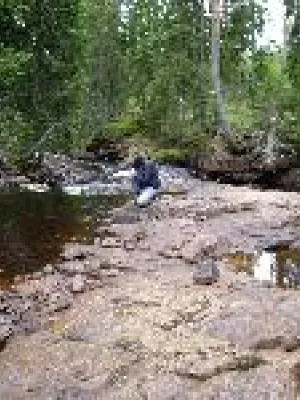
Sanna Alwmark
Postdoctoral fellow

A Mars 2020 Perseverance SuperCam Perspective on the Igneous Nature of the Máaz Formation at Jezero Crater and Link With Séítah, Mars
Author
Summary, in English
The Máaz formation consists of the first lithologies in Jezero crater analyzed by the Mars 2020 Perseverance rover. This formation, investigated from Sols (Martian days) 1 to 201 and from Sols 343 to 382, overlies the Séítah formation (previously described as an olivine-rich cumulate) and was initially suggested to represent an igneous crater floor unit based on orbital analyses. Using SuperCam data, we conducted a detailed textural, chemical, and mineralogical analyses of the Máaz formation and the Content member of the Séítah formation. We conclude that the Máaz formation and the Content member are igneous and consist of different lava flows and/or possibly pyroclastic flows with complex textures, including vesicular and non-vesicular rocks with different grain sizes. The Máaz formation rocks exhibit some of the lowest Mg# (=molar 100 × MgO/MgO + FeO) of all Martian igneous rocks analyzed so far (including meteorites and surface rocks) and show similar basaltic to basaltic-andesitic compositions. Their mineralogy is dominated by Fe-rich augite to possibly ferrosilite and plagioclase, and minor phases such as Fe-Ti oxides and Si-rich phases. They show a broad diversity of both compositions and textures when compared to Martian meteorites and other surface rocks. The different Máaz and Content lava or pyroclastic flows all originate from the same parental magma and/or the same magmatic system, but are not petrogenetically linked to the Séítah formation. The study of returned Máaz samples in Earth-based laboratories will help constrain the formation of these rocks, calibrate Martian crater counting, and overall, improve our understanding of magmatism on Mars. © 2022. American Geophysical Union. All Rights Reserved.
Department/s
- Lithosphere and Biosphere Science
Publishing year
2023
Language
English
Publication/Series
Journal of Geophysical Research: Planets
Volume
128
Issue
7
Document type
Journal article
Publisher
Wiley-Blackwell
Topic
- Geology
Keywords
- andesite
- basalt
- crater
- igneous rock
- Mars
- petrogenesis
Status
Published
ISBN/ISSN/Other
- ISSN: 2169-9097

